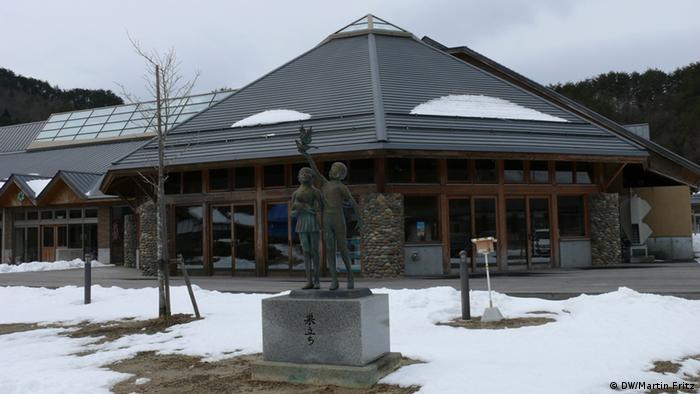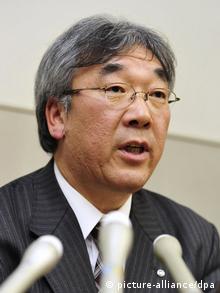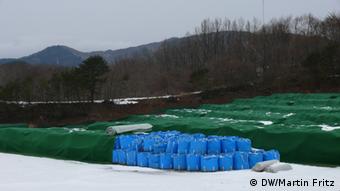Two years after the nuclear disaster in Fukushima, many of the
inhabitants of affected areas are reluctant to return despite expensive
decontamination efforts.
The electronic board in the playground at the elementary school in the
small town of Kawauchi displays 0.09 microsieverts per hour - much less
than the radiation level of 1 millisievert per year above which it would
be too dangerous to play outside.
However, only 16 out of 114 pupils have come back to school since the evacuation order was lifted. The 13 teachers, however, have all returned. But the headmaster Hitoshi Takashima is worried about another nuclear accident. "I can't forget how close the reactors are," he says.
"I'm not worried about the radiation," says Mariko, who is 10.
Kawauchi is located in a valley amid a sea of rice fields on hilltops still covered in snow at this time of year.
Two years ago, an earthquake and tsunami triggered a nuclear accident at the Fukushima Daiichi plant, 20 kilometers away. There were explosions in several reactors and a blanket of radioactive particles settled over the region like an invisible cloak.
After farming the land here for generations, the inhabitants of the valley were forced to evacuate the region.
Back to life
Today, the town is slowly coming back to life. Radiation levels are not as high as in other municipalities such as Tomioka, which is 20 minutes away by car and has been declared a no-go zone for five years.
The mayor Yuku Endo is doing his best to bring people back. "Kawauchi is in my genes," he says. "Home is the same as a life story."
He says resettling the 160,000 people who were evacuated two years ago, as was done with those living near Chernobyl in Ukraine, is not an option. "We cannot lose our pride in our lives here."
Expensive decontamination efforts
However, the decontamination of Kawauchi has already cost the equivalent of 83 million euros. In total, eight billion euros have been put into making the whole Fukushima region livable again. Not everybody wants to; the mayor says it is up to individuals to make up their own minds on whether to come back or not.
A quarter of Kawauchi's 2,800 inhabitants refuse to come back for now. Some 500 have returned and 700 come here to work everyday.
"There is fear of radiation, the broken reactors are still not under control and on top of that, Kawauchi doesn't have the comforts of a big city," Endo names as the reasons.
Most of those who have returned are pensioners who don't want to take the risk of starting anew elsewhere. "It's so sad that we don't hear children's voices here any more," says Keiko Shirai, 64, with tears in her eyes. However, she won't insist on her daughter and two grandchildren coming back. "If they get ill because of the radiation, she'll blame me."
Anyone who does choose to return is given a dosimeter to measure radiation levels.
But from April 1, it might not be so easy to stay away. From then on, the authorities will end housing support to evacuees on the grounds that certain areas have been decontaminated. Trees and bushes have been cut down and radiation levels have sometimes fallen by two thirds in some areas but not everywhere.
"We're still measuring one microsievert per hour in front of some house doors," says the man in charge of the decontamination efforts Juichi Ide That's four times the legal limit, which is why some are calling for a second decontamination campaign.
A reason to return
However, it was possible to plant rice again this year and the head of the farmers' committee Kazuo Watanabe is relieved. "Finally, the younger farmers have a reason to return," he says. The fact that the government has agreed to buy up the whole harvest allays fears that nobody will buy rice from this region."
Nevertheless, Watanabe is still angry. "The energy company TEPCO is to blame for this disaster."
Nonetheless, although he says the old myth about nuclear safety is dead, he admits that without TEPCO, the young people here, who only cultivate rice on the side, wouldn't have a job.
Those who did not farm or work for the 10 reactors in the Fukushima Daiichi and Daini plants used to work for schools, hospitals, nursing homes and the crematorium on the coast, which is now off-limits.
Solar instead of nuclear
So Endo wants to create a new infrastructure to attract other evacuees to Kawauchi. He rejects the straightforward solution which would be for operations to resume at the Fukushima Daini plant 12 kilometers south of the Daiichi reactors. "If we produce nuclear energy here again the whole world will laugh at us," he says. "We have to learn a lesson from this disaster otherwise it won't have meant a thing."
He has championed a 4.5 MW solar energy plant that is due to open on a territory of nine hectares in April. The Japanese-German project in one of the sunniest regions of Japan has exceptionally been approved, although Japanese law usually prohibits the use of arable land to build solar energy plants because food production takes priority.
"The solar plant takes up just three percent of the arable land but there could be more plants," says Manfred Rauschen, the CEO of the Hamm-based German company Öko-Zentrum.
Endo hopes that the whole of Fukushima prefecture will be running on "green" electricity by 2040.
However, the cesium from the nuclear reactors remains a problem. Currently, there are 35,000 huge blue sacks of contaminated soil, branches and leaves in rows under green tarps in a remote valley on the edge of the municipality.
The mayor says the waste is supposed to be taken away within three years but the authorities do not seem likely to fulfill this promise as there are no temporary storage sites.
However, only 16 out of 114 pupils have come back to school since the evacuation order was lifted. The 13 teachers, however, have all returned. But the headmaster Hitoshi Takashima is worried about another nuclear accident. "I can't forget how close the reactors are," he says.
"I'm not worried about the radiation," says Mariko, who is 10.
Kawauchi is located in a valley amid a sea of rice fields on hilltops still covered in snow at this time of year.
Two years ago, an earthquake and tsunami triggered a nuclear accident at the Fukushima Daiichi plant, 20 kilometers away. There were explosions in several reactors and a blanket of radioactive particles settled over the region like an invisible cloak.
After farming the land here for generations, the inhabitants of the valley were forced to evacuate the region.
Back to life
Today, the town is slowly coming back to life. Radiation levels are not as high as in other municipalities such as Tomioka, which is 20 minutes away by car and has been declared a no-go zone for five years.
The mayor Yuku Endo is doing his best to bring people back. "Kawauchi is in my genes," he says. "Home is the same as a life story."
He says resettling the 160,000 people who were evacuated two years ago, as was done with those living near Chernobyl in Ukraine, is not an option. "We cannot lose our pride in our lives here."
Expensive decontamination efforts
However, the decontamination of Kawauchi has already cost the equivalent of 83 million euros. In total, eight billion euros have been put into making the whole Fukushima region livable again. Not everybody wants to; the mayor says it is up to individuals to make up their own minds on whether to come back or not.
A quarter of Kawauchi's 2,800 inhabitants refuse to come back for now. Some 500 have returned and 700 come here to work everyday.
"There is fear of radiation, the broken reactors are still not under control and on top of that, Kawauchi doesn't have the comforts of a big city," Endo names as the reasons.
Most of those who have returned are pensioners who don't want to take the risk of starting anew elsewhere. "It's so sad that we don't hear children's voices here any more," says Keiko Shirai, 64, with tears in her eyes. However, she won't insist on her daughter and two grandchildren coming back. "If they get ill because of the radiation, she'll blame me."
Anyone who does choose to return is given a dosimeter to measure radiation levels.
But from April 1, it might not be so easy to stay away. From then on, the authorities will end housing support to evacuees on the grounds that certain areas have been decontaminated. Trees and bushes have been cut down and radiation levels have sometimes fallen by two thirds in some areas but not everywhere.
"We're still measuring one microsievert per hour in front of some house doors," says the man in charge of the decontamination efforts Juichi Ide That's four times the legal limit, which is why some are calling for a second decontamination campaign.
A reason to return
However, it was possible to plant rice again this year and the head of the farmers' committee Kazuo Watanabe is relieved. "Finally, the younger farmers have a reason to return," he says. The fact that the government has agreed to buy up the whole harvest allays fears that nobody will buy rice from this region."
Nevertheless, Watanabe is still angry. "The energy company TEPCO is to blame for this disaster."
Nonetheless, although he says the old myth about nuclear safety is dead, he admits that without TEPCO, the young people here, who only cultivate rice on the side, wouldn't have a job.
Those who did not farm or work for the 10 reactors in the Fukushima Daiichi and Daini plants used to work for schools, hospitals, nursing homes and the crematorium on the coast, which is now off-limits.
Solar instead of nuclear
So Endo wants to create a new infrastructure to attract other evacuees to Kawauchi. He rejects the straightforward solution which would be for operations to resume at the Fukushima Daini plant 12 kilometers south of the Daiichi reactors. "If we produce nuclear energy here again the whole world will laugh at us," he says. "We have to learn a lesson from this disaster otherwise it won't have meant a thing."
He has championed a 4.5 MW solar energy plant that is due to open on a territory of nine hectares in April. The Japanese-German project in one of the sunniest regions of Japan has exceptionally been approved, although Japanese law usually prohibits the use of arable land to build solar energy plants because food production takes priority.
"The solar plant takes up just three percent of the arable land but there could be more plants," says Manfred Rauschen, the CEO of the Hamm-based German company Öko-Zentrum.
Endo hopes that the whole of Fukushima prefecture will be running on "green" electricity by 2040.
However, the cesium from the nuclear reactors remains a problem. Currently, there are 35,000 huge blue sacks of contaminated soil, branches and leaves in rows under green tarps in a remote valley on the edge of the municipality.
The mayor says the waste is supposed to be taken away within three years but the authorities do not seem likely to fulfill this promise as there are no temporary storage sites.




沒有留言:
張貼留言